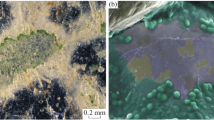Abstract
Microbial communities of alluvial soils in the facies on islands in the Selenga estuary and near Stepnoi Dvorets and Istomino Settlements were studied. The distribution of the CFU-dominant microorganisms (Bacillus and Pseudomonas + Arthrobacter) has been revealed in the studied island soils. In addition, actinomycetes Streptomyces were found among the dominants in soils of the near-terrace floodplain. The quantitative distribution of microorganisms across soil layers was demonstrated. The effect of ecological factors in formation of microbial communities on the islands and central floodplain regions was revealed.
Similar content being viewed by others
REFERENCES
Bergey's Manual of Determinative Bacteriology. Holt, J.G., Krieg, N.R., Sneath, P.H.A., Staley, J.T., and Williams, S.T., Eds., Baltimore: Williams and Wilkins, 1994, 9th ed.
Barykova, Yu.N., Comparative Description of Microorganisms in Onon-Argunskaya and Koibal'skay Steppes, in Mikroflora pochv i vodnykh basseinov Sibiri i Dal'nego Vostoka (Microflora of Soils and Water Bodies in Siberia And Far East), Tomsk: Tomsk. un-t, 1976.
Buryukhaev, S.P. and Namsaraev, B.B., Involvement of Microorganisms of Bog Ecosystems in Water Quality Formation in the Baikal Region, in Fundamental'nye problemy vody i vodnykh resursov na rubezhe tret'ego tysyacheletiya. Mater. Mezhdunar. nauchn. konf. 3–7 sentyabrya 2000 g. (Fundamental Problems of Water and Water Resources on the Boundary of the Third Millennium: Proc. Int. Sci. Conf. Tomsk, September 3–7 2000), Tomsk: Nauchno-technicheskaya lit., Tomsk, 2000, pp. 503–505.
Buryukhaev, S.P., Namsaraev, B.B., Ul'zetueva, I.D., Dagurova, O.P., and Khakhinov, V.V., Hydrobiological and Hydrochemical Monitoring of the Selenga Estuary, in Selenga—reka bez granits. Mater. Mezhdunar. nauchnoprakticheskoi konf. (Selenga, an Unbounded River. Proc. Sci. Appl. Conf.), Ulan-Ude, 2002, pp. 106–109.
Buryukhaev, S.P., Namsaraev, B.B., Korsunov, V.M., and Gonchikov, G.G., The Abundance of Microorganisms and the Dynamics of Decomposition Rates in Low-Moor Bogs of the Baikal Region, Pochvovedenie, 2003, no. 1, pp. 81–89.
Dobrovol'skaya, T.G., Struktura bakterial'nykh soobshchestv pochv (Structure of Bacterial Communities of the Soil), Moscow: Akademkniga, 2002.
Dobrovol'skaya, T.G., Skvortsova, I.N., and Lypak, L.V., Metody vydeleniya i identifikatsii pochvennykh bakterii (Methods for Isolation and Identification of Soil Bacteria), Moscow: Mosk. Gos. Univ., 1989.
Golovchenko, A.V. and Dobrovol'skaya, N.G., Population Density and the Reserves of Microorganisms in Flood-Plain Soils of the Protva River, Pochvovedenie, 2001, no. 12, pp. 1460–1464.
Kazazaeva, M.V., Shakhmatova, E.Yu., and Korsunov, V.M., Morphological and Chemical Properties of Alluvial Soils in the Selenga Estuary, Selenga—reka bez granits. Mater. Mezhdunar. nauchno-prakt. konf. (Selenga, an Unbounded River. Proc. Sci. Appl. Conf.), Ulan-Ude, 2002, pp. 66–68.
Kulikov, A.I., Dugarov, V.I., and Korsunov, V.M., Merzlotnye pochvy: ekologiya, teploenergetika i prognoz produktivnosti (Permafrost-affected Soils: Ecology, Heat Energetics, and the Prediction of Their Productivity), Ulan-Ude: Buryatsk. Nauchn. Tsentr, 1997.
Makushkin, E.O. and Korsunov, V.M., Microorganisms of Floodplain Soils in the Selenga Estuary as a Destructor of Organic Substrates, Bioraznoobrazie i funktsionirovanie mikrobnykh soobshchestv vodnykh i nazemnykh sistem Tsentral'noi Azii. Ulan-Ude. Mater. Vseros. konf. (k 70-letiyu akad. G.A. Zavarzina (Biodiversity and Functioning of Aquatic and Land Systems in the Central Asia. Ulan-Ude. Proc. All-Russian Conf. (on the 70th Anniv. of Acad. G.A. Zavarzin), Ulan-Ude: BGSKhA, 2003, pp. 177–179.
Makushkin, E.O. and Shakhmatova, E.Yu., Microbial Activity of the Soil in the Selenga Estuary as a Factor Controlling Organic Matter Transformation, in Pochvy natsional'noe dostoyanie Rossii. Mater. IV s”ezda Dokuchaevskogo obshch-va pochvovedov. 9–13 avgusta 2004 g. Kniga 1 (Soils Are National Patrimony of Russia. Abstr. IV Congress of the Dokuchaev Society of Soil Scientists. August 9–13, 2004. Book 1), Novosibirsk: Nauka-tsentr, 2004.
Makushkin, E.O., Korsunov, V.V., and Khakhinov, V.V., Description of the Microbial Community Status in the Selenga Estuary by the Metabolic Coefficient and Biomass, Nauka i prepodavanie distsiplin estestvennogo tsikla v obrazovatel'nykh uchrezhdeniyakh. Mater. region. nauchnoprakt. konf. (Science and Teaching Natural Sciences in Educational Institutions. Proc. Regional Sci. Appl. Conf.), Ulan-Ude, 2002, pp. 23–24.
Makushkin, E.O., Sorokin, N.D., Korsunov, V.M., Shakhmatova, E.Yu., and Afanasova, E.N., Specific Features of Microbial Complexes of Island Soils in the Selenga Estuary as a Marker of Permafrost Effect of the Baikal Lake, Merzlotnye pochvy: raznoobrazie, ekologiya i okhrana. Mater. vseros. nauchn. konf., posvyashchennoi IV s”zdu Dokuchaevskogo obshchestva pochvovedov i 100-letiyu so dnya rozhdeniya prof. V.G. Zol'nikova (Cryogenic Soil: Diversity, Ecology, and Conservation. Proc. All-Russian Conf. on the IV Congress of the Dokuchaev Society of Soil Scientists and the 100th Anniv. of Acad. V.G. Zol'nikov), Yakutsk: IPBK of the Siberian Branch of the Russian Academy of Sciences, 2004a, pp. 66–72.
Makushkin, E.O., Shahmatova, E.U., Sorokin, N.D., and Aphanasova, E.N., Ecological Conditions of Microbiological Transformation of Soil Organic Matter in the Delta of the Selenga River, in Science for Watershed Conservation: Multidisciplinary Resource Management. International Conference Abstracts. Ulan-Ude (Russia)-Ulan Bator (Mongolia), September 1–8, Ulan-Ude: Buryat Scientific Center, Siberian Branch, Russian Academy of Sciences, 2004b, vol. 2, pp. 120–122.
Nikitina, Z.I., Composition and Dynamics of Microbiocenoses, Prirodnye rezhimy Minusinskoi kotloviny (Natural Conditions of the Minusinsk Depression), Novosibirsk: Nauka, Sib. Otd-nie, 1976, pp. 19–41.
Nimaeva, S.Sh., Mikrobiologiya krioaridnykh pochv (Microbiology and Cryoarid Soils), Novosibirsk: Nauka. Sib. Otd-nie, 1992.
Shakhmatova, E.Yu., Kazazaeva, M.V., and Korsunov, V.M., Study of the Role of Hydromorphic Soils in the Selenga Estuary by the Chemical Composition of Soil/Subsoil Waters, Selenga-reka bez granits. Mater. mezhdunar. nauchno-prakt. konf. (Selenga, an Unbounded River. Proc. Sci. Appl. Conf.), Ulan-Ude, 2002, pp. 104–106.
Zvyagintsev, D.G., Dobrovol'skaya, T.G., Chernov, I.Yu., Sardanashvili, E.S., Gonchikov, G.G., and Korsunov, V.M., The Peculiarities of Taxonomic Composition of Microbial Complexes in Soils of Baikal Region, Pochvovedenie, 1999a, no. 6, pp. 727–731.
Zvyagintsev, D.G., Polyanskaya, L.M., Gonchikov, G.G., and Korsunov, V.M., The Biomass of Microorganisms in Soils of the Transbaikal Region, Pochvovedenie, 1999b, no. 9, pp. 1132–1139.
Author information
Authors and Affiliations
Additional information
__________
Translated from Izvestiya Akademii Nauk, Seriya Biologicheskaya, No. 5, 2005, pp. 545–551.
Original Russian Text Copyright © 2005 by Makushkin, Sorokin, Korsunov, Shakhmatova, Afanasova.
Rights and permissions
About this article
Cite this article
Makushkin, E.O., Sorokin, N.D., Korsunov, V.M. et al. Patterns of Formation of Microbial Communities of Alluvial Soils in the Selenga Estuary. Biol Bull Russ Acad Sci 32, 450–455 (2005). https://doi.org/10.1007/s10525-005-0123-1
Received:
Issue Date:
DOI: https://doi.org/10.1007/s10525-005-0123-1




